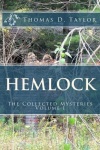People interested in getting a glimpse into Detective James Hemlock’s life and the horrors he discovers during his investigations should have a look at this…
“Hemlock: The Collected Mysteries” is available in a Kindle file and in paperback on Amazon. It is currently FREE to Kindle Unlimited members.
“Hemlock: The Collected Mysteries (Volume 1)”
(Can be found here and here)
Excerpt from “No Crocodile Tears Permitted”
Hemlock was not familiar with any kind of demonology, but had he been, he would have quickly understood that the worst specimens of fallen angels were represented here. They were laid out like chess pieces on a board, with the bare middle rows of the field forming a kind of street through the nightmare. There would be no way that a person could traverse the track without perturbation and accumulating dread, knowing that such lifelike representations of the most accursed ambassadors from the infernal regions of Hell were looking down upon him.
They were mind-bending creations. Each one was an amalgam of earthly creatures and creatures of no kind the earth had ever seen. One was a many legged creature with a body that seemed to be composed of mostly eyes and pinchers. Another was a many-headed animal with screaming mouths, and multiple tongues. There was no way to describe most of them, but it made Hemlock shudder when he thought of the sculptors who must have spent untold hours working on them. To be so close to them, and to look at them for days as the final forms were slowly chiseled out of the rock, or marble, or concrete, or whatever material happened to comprise each varying shape… It would drive a sane man mad, though it might delight a wicked man, and feed an insane man’s mania.
Excerpt from “The Loop in the Underground”
But he didn’t have time to pursue that line of thought. There was a clicking sound and Plum was on the line.
“Ah, Mr. Hemlock. I see you’ve found another one of my little hiding spots.”
“Yep. Have your wounds healed yet? I seem to remember that during our last encounter I stabbed you with a machete and punctured you with a bullet or two.”
“I’m fine, thank you. You do realize that your calling me right now seals your fate, don’t you? I have men and women going down there to finish you off?”
“Are you so extraordinarily stupid as to think that I haven’t planned for that? If they come down here, they’ll die. If you want to save their lives, you would do well to call them off.”
“They are expendable, and will be rewarded in Hell if they die. They know this, which is why they will come for you no matter what you have waiting for them.”
Excerpt from “Death Screams Eternal”
There was a splintering, tearing sound, and the boy fell through the floor and into the crawl space beneath the chapel.
Bones broke his fall.
Hundreds of bones.
Thousands of bones.
Maybe tens of thousands of bones.


